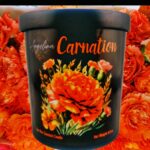- May 20, 2024
Frankincense
Scents & Scent’s Ability – Frankincense
Who is this coming out of the wilderness
Like pillars of smoke,
Perfumed with myrrh and frankincense,
With all the merchant’s fragrant powders?
(Song of Solomon 3:6)
For thousands of years, frankincense has been used in spiritual rituals as a symbol of holiness, as well as in perfumes, anointing oils, and medicine. In Biblical times, frankincense was used as an offering to God and as a symbol of God’s holiness; it was also used as part of burnt offerings. To this day, churches burn frankincense as ritual purification and cleansing to make a place worthy of worship. In traditional Ayurvedic practice, frankincense has been used for its anti-inflammatory properties to treat pain related to arthritis, bursitis, tendonitis, and other inflammatory diseases such as asthma.
In natural skin care, frankincense essential oil is known as the “King of Essential Oils” because it is an antioxidant that helps protect skin cells and keeps skin moisturized. It has been known to reduce fine lines and wrinkles, as well as lift and tighten skin, making it ideal for use in skin care products, especially for mature skin. Frankincense can even treat acne flare-ups. Additionally, its anti-inflammatory properties help soothe irritated skin, making it beneficial for conditions like eczema and psoriasis. Its astringent qualities can help balance oily skin and reduce the appearance of pores, providing a more refined and smooth complexion. Regular use of frankincense in skin care routines can promote an even skin tone and help fade scars and dark spots due to its skin regenerative properties.
As an aromatherapeutic, frankincense is used to enhance mood, combat stress and anxiety, and promote creativity.
Frankincense is an oleo-gum resin produced by various species of the Boswellia tree. There are about 20 species in the Boswellia genus. Frankincense is most often collected from Boswellia sacra, Boswellia carterii, and Boswellia frereana. Boswellia trees are native to tropical regions in Africa and Asia, including Yemen, Pakistan, India, and Ethiopia. The most prized species of frankincense comes from Boswellia sacra, which is native to Oman. Boswellia sacra frankincense (also known as “Hojari”) is light in color with a translucent appearance indicating purity, and has a complex aroma that is prized in perfume making, described as smelling sweet, citrusy, and slightly spicy.
To collect the resin from the tree, an incision is made into the bark, deep enough to penetrate the cambium layer (the growing part of a tree trunk that annually produces new bark). This process does not harm the tree if done properly. The tree will then produce a milky white sap, which is the resin. Typically, the resin produced by the first cut is discarded due to impurities. Subsequent incisions will produce higher quality resin. The resin is then left to dry on the trees for a period of weeks to months, depending on climate and other environmental factors. As the resin hardens, it forms tear-shaped droplets. The dried, hardened resin is then scraped off the trees and collected, then sorted by size, color, aroma, and purity. It is then ready for the distillation process.
Once the frankincense is placed into the distillation device, steam is introduced into the chamber containing the frankincense, and as the steam passes through the resin, it becomes soft and releases its oil. The essential oil-laden steam is then channeled through a condenser where it is cooled and reverts to liquid form. Once the oil and water separate, the oil is collected, and any impurities are removed if necessary. It can take between 5 and 10 pounds of frankincense resin to make one ounce of essential oil, depending on various factors including the efficiency of the distillation process, temperature, and the duration of the distillation process.
From ancient spiritual rituals to modern therapeutic and cosmetic uses, frankincense has proven its remarkable versatility and value. Its rich history and multifaceted applications continue to make frankincense a treasured commodity around the world. Whether used in religious ceremonies, as a natural remedy, or as a key ingredient in natural skincare, frankincense remains unmatched, demonstrating its enduring significance across cultures and generations.










